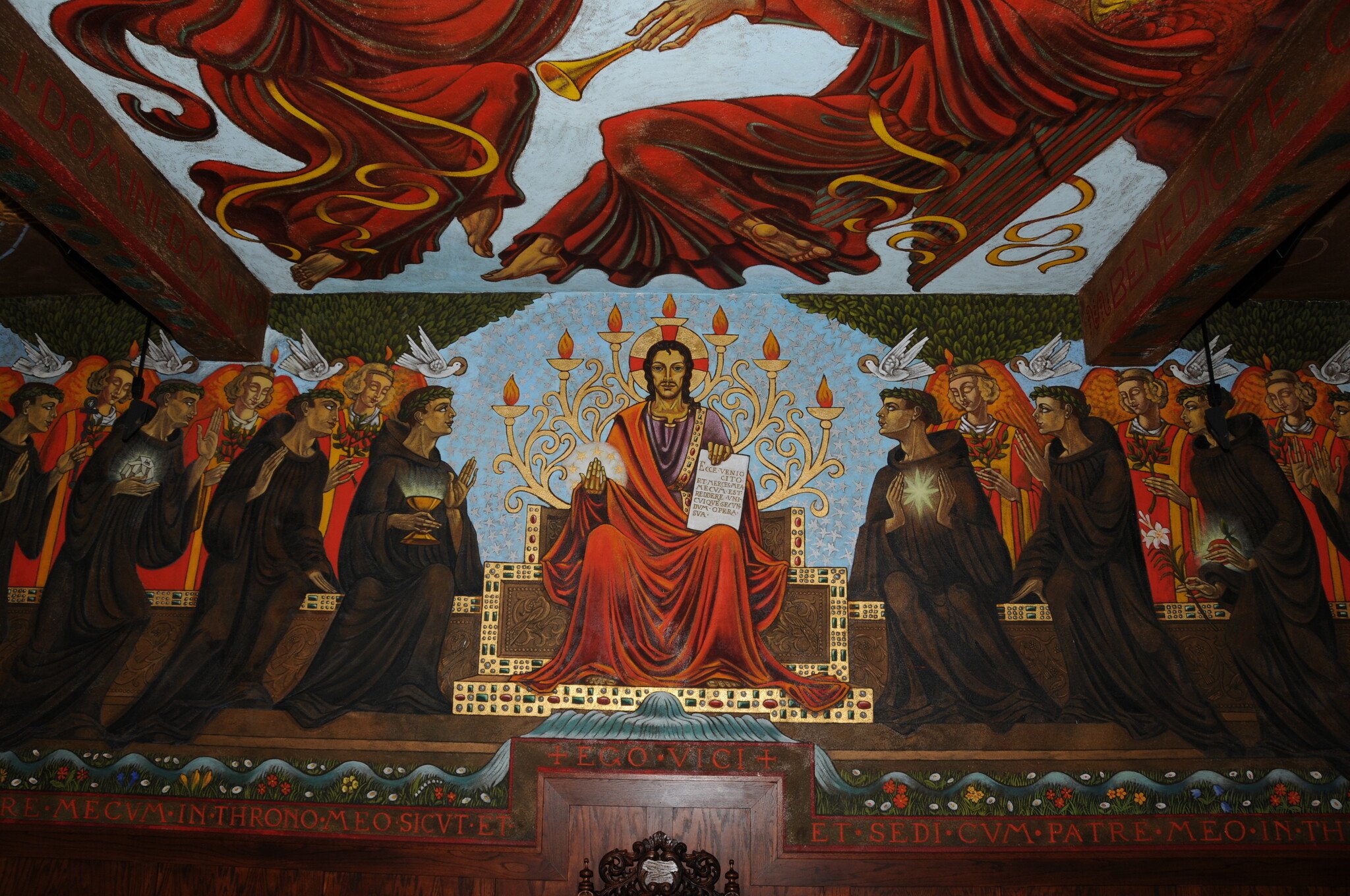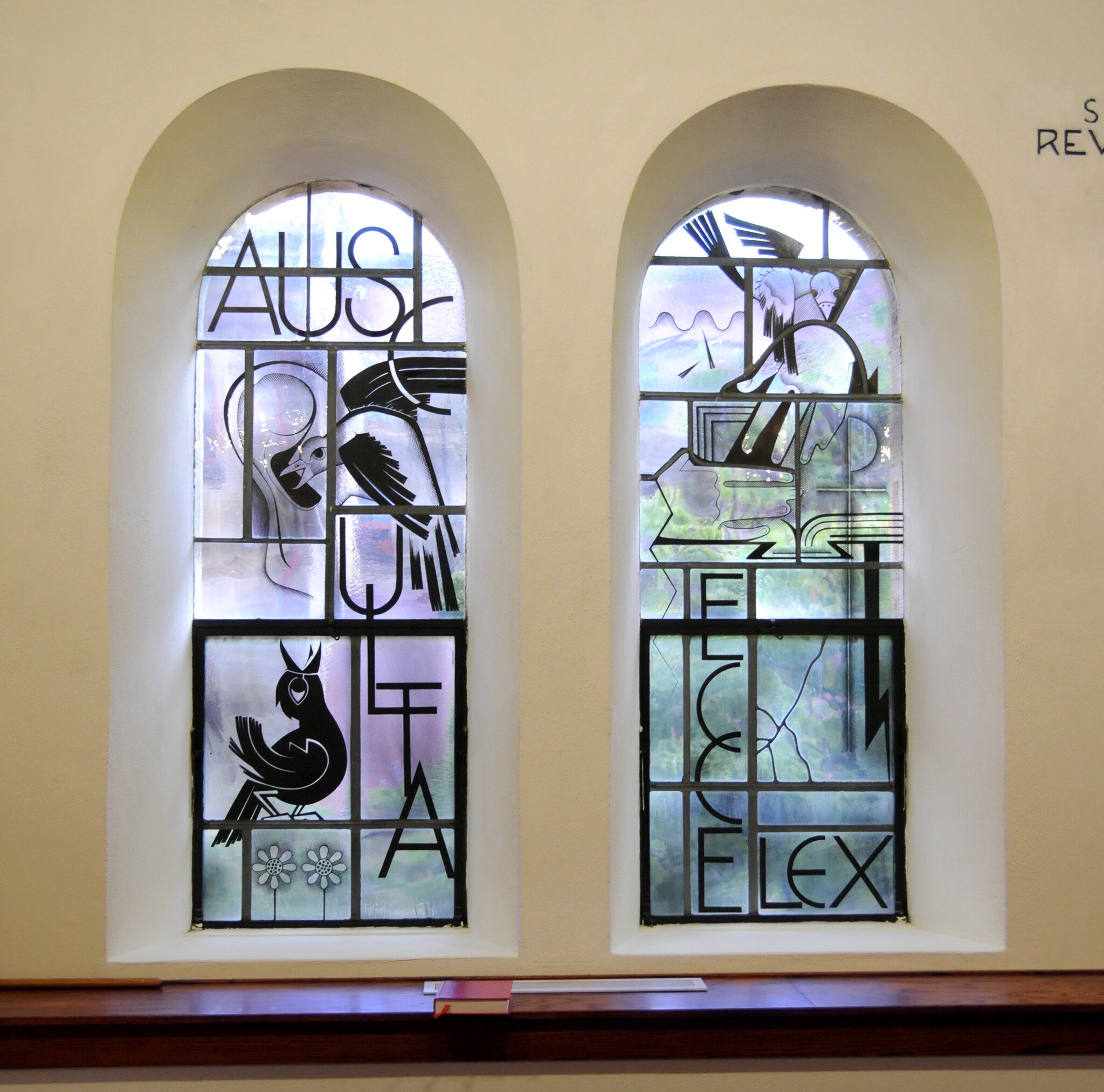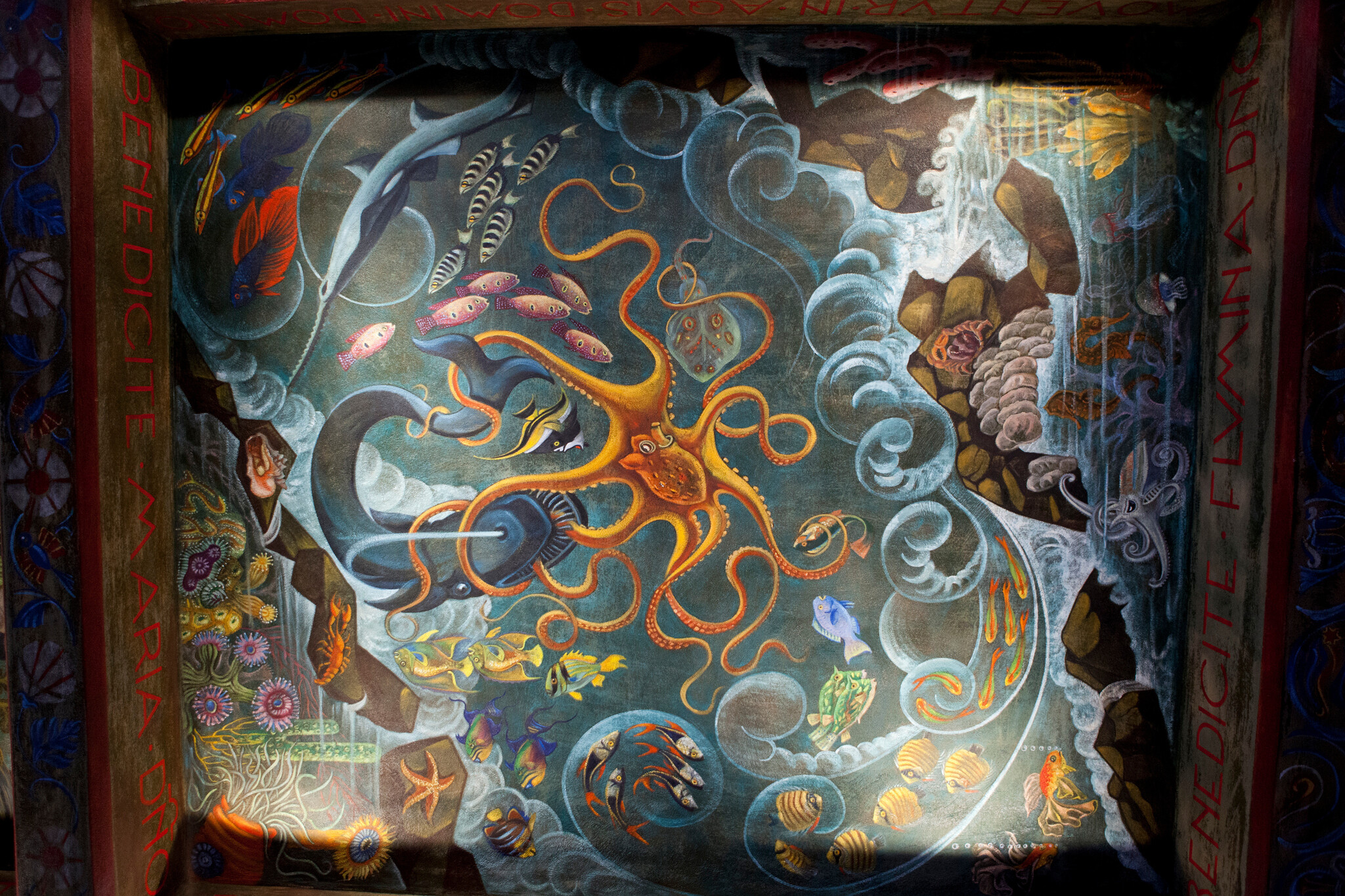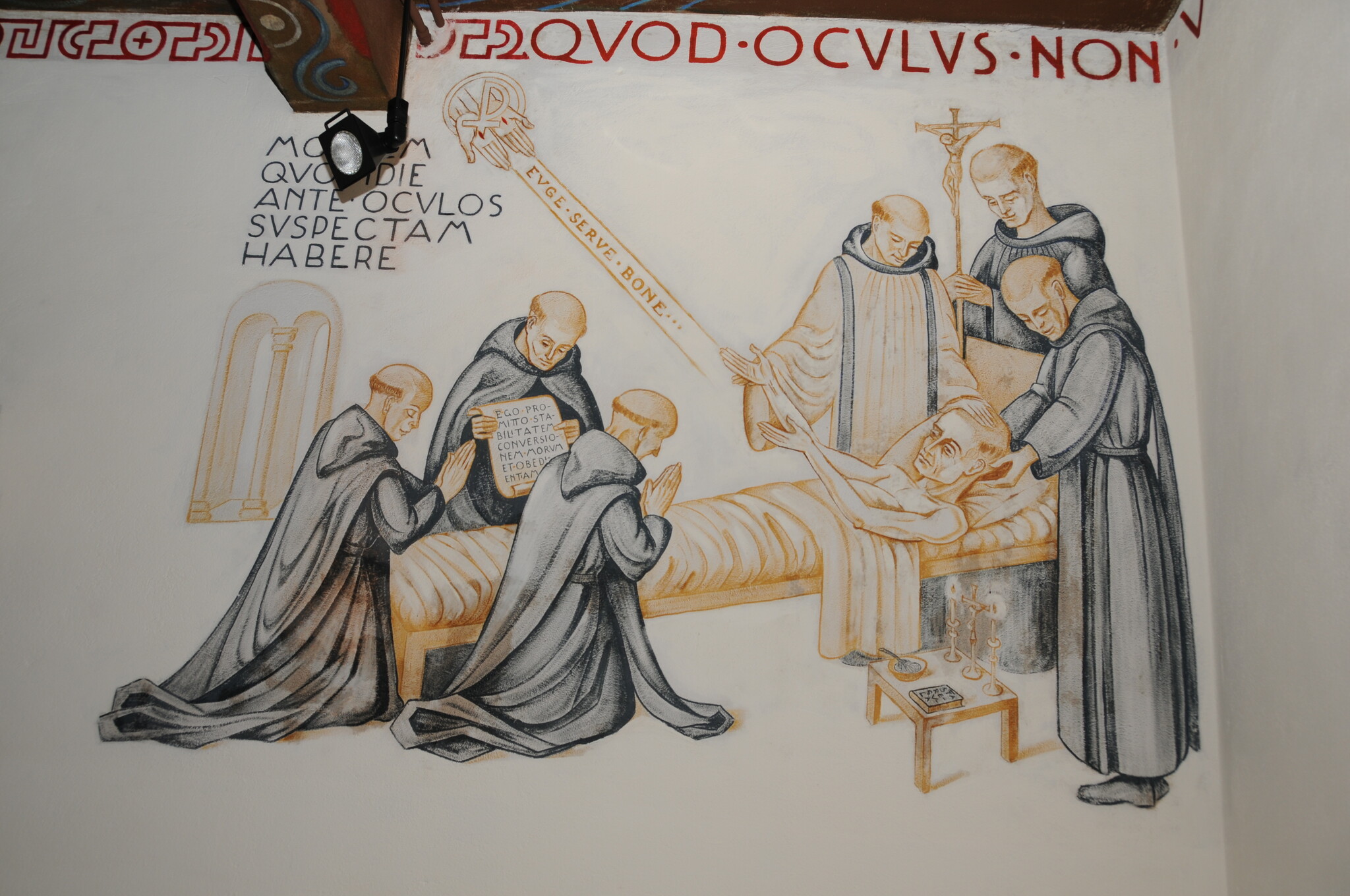CHAPTER ROOM: The Art of Monastic Life
- Posted on

Visitors to Saint Meinrad typically enjoy the artwork found in the buildings and on the grounds, but the Chapter Room stands alone for its sheer amount and variety of art.
Visitors to Saint Meinrad typically enjoy the artwork found in the buildings and on the grounds, but the Chapter Room stands alone for its sheer amount and variety of art.
The Chapter Room is a special room in a monastic community. It’s where the business of the monastic family takes place – meetings, spiritual talks, official reports. At Saint Meinrad, the Chapter Room is off of the second floor of St. Anselm Hall, which was the monastery until a new one was built in the 1980s.
For the first 30 years, the Chapter Room was a plain, rectangular room. Then Abbot Ignatius Esser, OSB, commissioned an artist monk from the Abbey of Mont César in Belgium to decorate the space. The project took about six months, and it was dedicated on March 21, 1943.
The artist was Fr. Gregory de Wit, whose work also can be found in the Archabbey Church (the Christus on the east wall) and Memorial Lobby (murals of St. Benedict and St. Meinrad). When visitors tour the Chapter Room, they enter through the room’s only door and walk into a room filled with meaning and art.
If These Walls Could Talk

The walls feature images depicting passages from the Rule of St. Benedict. In one scene, a monk is seated on a bench with an open book on his lap. He holds a finger to his lips. The Latin text around the image is: Multum loqui non amare, which translates as “not to love much speaking,” or “prefer moderation in speech.” This is taken from Chapter 4 of the Rule.

Another painting by Fr. Gregory shows a poor shepherd at the door to the monastery. One of the monks is kissing his feet while another is setting a bowl of soup on the table for the man to share with them. If you look closely, you’ll see the visitor has a halo around his head with a cross in it: a sign of Christ.
St. Benedict wanted his monks to see Christ in everyone and receive all guests as if they were Christ. The text from the Rule says: “Because in the poor, Christ is more especially received.”
A Window into Monastic Life
Between the various paintings on the wall are 24 windows, grouped in pairs, with six pairs on opposite sides of the room. Here, Fr. Gregory sought to evoke the meaning of the monastic vocation.

Each window features a Latin word or phrase. In the first window, you can see the word Ausculta, which is the first word of the Rule – listen. The window also contains a giant ear, a baby bird and an adult bird. The young bird stands with mouth open wide, eager to receive the food the parent is about to provide. The inference is that the viewer should be as eager to hear the Word of God.

The windows follow an old rule of church decoration: when the walls are colored, the windows are not. These windows are made of clear glass, tinged with a greenish gray hue. All the letters and figures are made of heavy lines in plain black.
Look Up for a Scripture Story

The most colorful and lively art was painted on the ceiling, where Fr. Gregory depicted scenes from the canticle of the three children, from the Book of Daniel. Each of the six center panels illustrates part of the story. Alongside each painting is a corresponding verse.
For example, on the panel illustrating the plants and fish of the sea are the Latin words for “You dolphins and all water creatures, bless the Lord.”

Alongside these panels are 12 smaller panels on which the artist has painted the symbols of the Zodiac, along with their names and constellations.
A Mural of Revelation

Dominating the back wall of the Chapter Room is a mural, featuring Christ in the center sitting on a throne. In his right hand, Christ holds the seven stars mentioned in the Book of Revelation. In his left hand is a document with Latin words that translate as: “Behold I come quickly, and my reward is with me, to render to each one according to his works.”
On each side of Christ are five monks, walking toward Him and preparing to receive their heavenly reward. Below Christ’s throne is a stream of living water that gushes forth and runs along the mural to the right and left.
Beside each monk is the guardian angel who accompanied him through life. Above each head is the dove or spirit who served as a guide. Laurel wreaths have been formed by the angels and placed on the heads of the monks.
These Monks Guard the Entrance
As you turn back toward the entrance, two large wood-carved figures of monks flank the doorway. Across the shoulders of these eight-foot monks is a large, gilded beam that spans the top of the doorway, carved with the words Jugum Stae Regulae – Yoke of the Holy Rule. This refers to the Rule of St. Benedict.
One monk holds a bowl of holy water and the other holds a cross. These monks were carved by Br. Herman Zwerger, a monk of Saint Meinrad, following the clay models made by Fr. Gregory.
A (Paint)Brush with Death
As you leave the Chapter Room, you’ll notice two paintings that illustrate death are found above the entrance.
On one side is depicted the dying moments of St. Benedict. Just before he died, he commanded his monks to carry him into the oratory, where he could receive Communion. With his hands lifted up to heaven in prayer, he gave his last breath.

In the second painting, the monks are reminded by St. Benedict “to keep death daily before one’s eyes.” In this piece, a monk on his deathbed is surrounded by his confreres. One of the monks holds a copy of the dying man’s vow chart, signed at the time of his profession.
The monk seems to be reaching up toward heaven. The hand of God is reaching down and the Latin words for “Well done, good servant” are etched into the ray from heaven.
